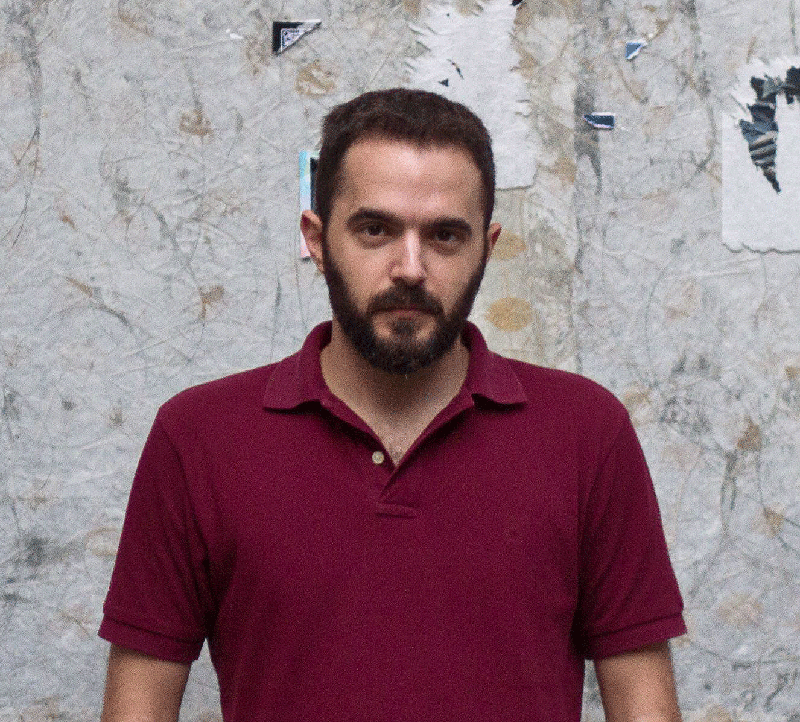Interview by: Nondas Douzinas
Nikos Moschos presents his works of art at Xippas Gallery in Kolonaki...
...in an exhibition which lasts up until 26 January 2013.
Thanks to this exhibition, www.culturenow.gr had the pleasure and the opportunity to chat with the artist, who “guided” us into the deeper paths of his paintings and his style, as well as into his general approach towards his art, mainly painting. His responses were particularly interesting, which will surely be made apparent to the readers of this interview.

Culturenow.gr: Will you describe the exhibition for us? Which title would be suitable?
Nikos Moschos: It's a bit difficult to describe, to condense my work into one word or even a phrase. This role is entitled to shapes and colors. This is one of the reasons why I think it's pointless to name my paintings anymore, let alone a whole exhibition, as most times the interaction between the viewer and the image is caged in finite borders. At this point, however, I'd like to mention that an exception is the painting “Happy Birthday to me”, although I'm sure I wouldn't lose any sleep over it being untitled.
Cul.N.: What did you want to express through the pieces you included in the exhibition?
N.M.: I tried in a way to provoke the feelings that come over a person in a self-contained border, structured with recognizable but also vague-abstract elements, where everything is happening right then and there, with the cause and effect coexisting simultaneously. The main purpose of each painting is to justify the result through the coexistence of dissimilar elements with unexpectedly natural results.
Cul.N.: “Despite the apparent structural anarchy, Nikos Moschos' pieces are highly sophisticated compositions.” Why have you chosen to express yourself in such manner?
N.M.: These compositions arose through my effort to discard anything I deemed redundant in my paintings so far, which in the end, I think, made them significantly weaker. Some obsessions in shapes that dominated my paintings were inevitably transformed to become a more direct and clear pathway towards the desired result. I basically wanted to change the points that concealed my true intentions.
Cul.N.: How did art get into your life and what drew you to painting?
N.M.: I have been painting ever since I can remember. My father, besides an art restorer, is a painter himself, which influenced me greatly, without any kind of pressure from his part. His workshop was, and still is, one of my favourite places, where I spent countless hours studying, copying and conversing.
Cul.N.: Besides painting, you have also studied photography. Which is your favourite?
N.M.: I was involved with photography more intensively while I was at the university. During the last few years I am limited to photos of my paintings in-between stages as well as commemorative photography.
Cul.N.: What are your artistic influences?
N.M.: I would need several lines to answer comprehensively, as I have numerous favourite moments throughout history and the various forms of art. I have also spotted quite a few times (mainly in older pieces) the marks of artists which I hadn't bothered with-or so I thought. This means that the number of influences, albeit subconsciously, is greater than I thought. Nevertheless, in retrospect, I would note various ancient Greek and Byzantine works of art, the Venetians Tintoretto and Tiziano, El Greco, Velázquez and Goya, as well as the incredible attraction exerted by the paintings of the Flemish and Dutch masters. Later, I became highly interested in Expressionism and the New Objectivity (Dix, Beckman, Grosz) as well as Bacon's distortions and De Kooning's inexhaustible palette.
Cul.N.: What do you do differently in your work now, as opposed to the beginning of your career?
N.M.: I consider everything I conquer technically and mentally, which stems from the incessant studying and the constant contact with the materials, to play a determining role in the development and insight. I constantly feel like I am on a course towards self-awareness. Gradually, the searches in technical matters which conformed with a quite descriptive representation of the world, gave way to issues with my emotions and my psyche as a priority. That is where my personal style originates from, effortless, without much thinking, free from lessons of the past.
Cul.N.: Are you influenced by current affairs when you paint?
N.M.: With a quick look at the pieces, but also when you focus on some parts, you can feel a sense of panic and alarm. Associating them with specific events is absolutely justifiable. But what concerns me is people and their temperament, in situations where they are both components and subjects unable to react and escape. The feeling of this knowledge on their part and the fact that they are responsible without being able to avoid or interfere with their destiny because of their animal instincts is one of the issues that fascinate me and constitute the basis of my work. I'm not interested in expressing an ideology or social injustice as it happens in various forms of politically motivated art. For instance, a gas mask is obviously a protection measure tightly linked to fighting but at the same time seeing it causes the panic and distress of asphyxiation. It's up to the viewer to interpret it. I believe that man and his needs are no longer in the center of attention and in their place are inferior interests embellished with various ideologies. Left or right wing, are both equally inadequate for me.
Cul.N.: What are your plans for the future, after this exhibition?
N.M.: I will keep working intensively. That's enough for me.